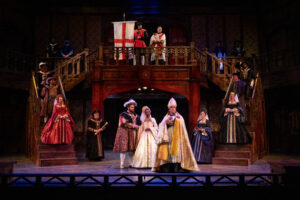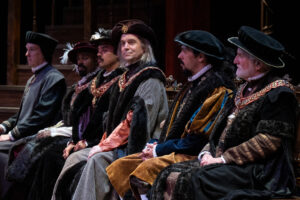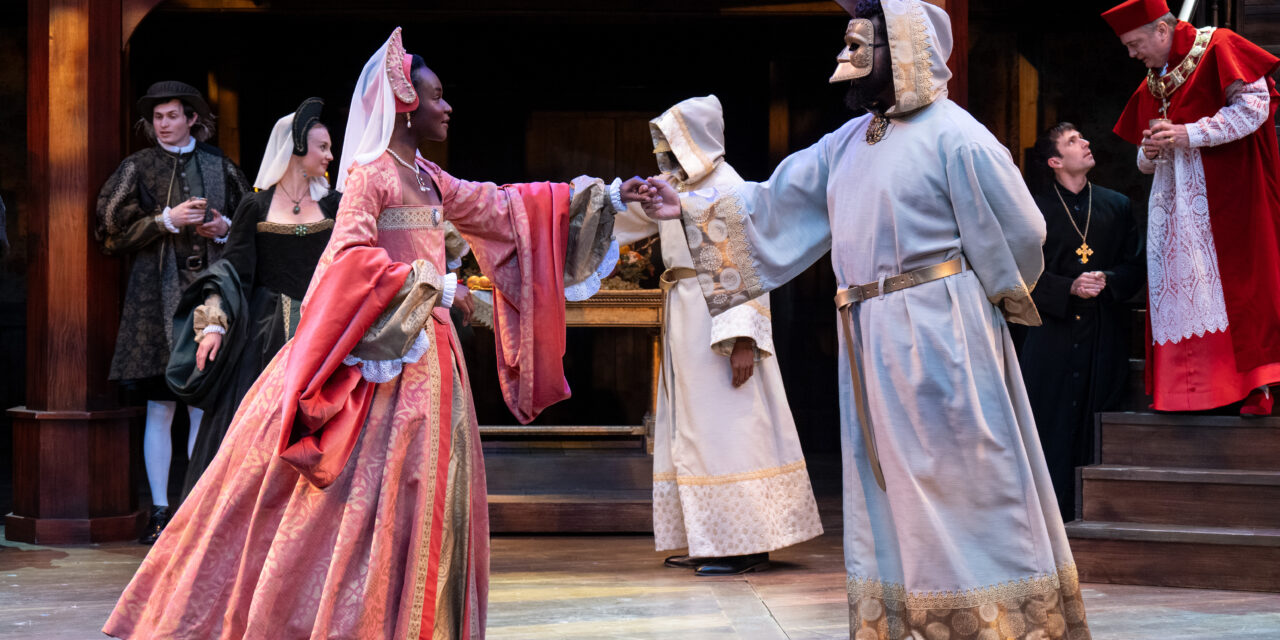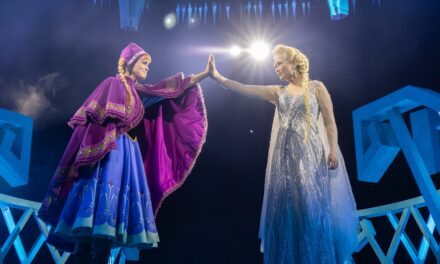CEDAR CITY — A historical figure who was once little more than a footnote in American civics courses has burst back into the limelight due to the outrageous popularity of the girl power pop musical SIX. The story of England’s King Henry VIII is vilified today for his misogyny towards women but was once revered as a foreordained though complex monarch for siring England’s great queen of Shakespeare’s Time, Elizabeth I. It is the second tale spun by the Bard of Avon, perhaps to please his regal benefactor, that plays on the Englestad Shakespeare Theatre stage as part of the annual Utah Shakespeare Festival.
Henry VIII is a rarely performed history that helps the festival’s long standing goal of completing the canon. By the play’s own admission, “‘Tis ten to one this play can never please // All that are here.” But the strength of this production lay in powerful acting performances from the show’s leading players and strong direction.
Director Derek Charles Livingston was exceptional in guiding his cast and creative team in using non-verbals to tell this story. One of the most striking images from the play was a banquet table with feast trays stacked on top of one another, and crowned with a full roasted pig on top. The set piece was the center of Cardinal Wolsey’s party where he and King Henry had just been petitioned by people who were starving due to the Cardinal’s grievous tax of one-sixth of their production. At another time, an executioner crossed the stage wordlessly with a blood stained axe interrupting a conversation between two gentlewomen, and inspiring their line, “We are too open here to argue this; // Let’s think in private more.” These unspoken moments were part of an exceptional understanding of the play. Its subtext may not have landed with those who “come to take their ease // And sleep an act or two;” but astute Shakespeare fans who are excited by the chance to see an exceptionally performed – and uncommon to see – play will love these choices by Livingston and his team.

Henry VIII plays through September 5, 2024 | Photo by Karl Hugh. Copyright Utah Shakespeare Festival 2024.
Cassandra Bissell was stellar as Queen Katherine. Her stoicism at the beginning of the production set the tone for a production that delivered many painful barbs. Unlike the festival’s offering of The Taming of the Shrew, there’s no ducking the awful treatment of Katherine in this production. Bissell exceptionally played the woman scorned. She fought fiercely with the Cardinals, plead desperately for Henry to not turn a cold shoulder, and when she was summoned, there was no question that she, with broken heart, would not come. Bissell was regal at every turn and was alone worth the price of admission.
Chris Mixon was a striking Cardinal Wolsey. He avoided any emotional exertion which fit the part, but the cardinal’s Machiavellian nature was clear in the asides that Mixon found to make to others on stage. When he feigns innocence to the burdening people with taxes, he only tips his hand when he pulls aside a scribe to ensure that his name is tied in rumor to the lifting of his own infliction. Mixon silently maneuvered the stage as the holy fox to seek to move the chess pieces and when he was so often unsuccessful, his disappointment was subtle but clear.
Topher Embrey did something that was surprising in playing the play’s titular character. In his performance, the character seemed to act almost completely without guile. By today’s standards, forming a new religion so you can justify a divorce and pursue a younger woman to produce an heir is, understandably, icky. Embrey, however, played the King as surprised at every turn that his actions impacted others. When told about the tax levied on the people, Embrey showed the King had concern and demanded its repeal. When Katherine was ruffled by his infidelity, Embrey appeared genuinely conflicted. It’s easy to play off Henry VIII as a typically misogynist and self-serving king, but there was something in the wide eyed, aloof, even boyish air that Embrey brought to the stage that made his character, if not sympathetic, at least human.

Photo by Karl Hugh. Copyright Utah Shakespeare Festival 2024.
The show was a smashing technical success as well. Henry VIII was notoriously lavish in his attire. Outfits often included excessively padded sleeves and shoulders in sumptuous doublets and the King is often viewed wearing bejeweled hats. Costume designer Bill Black had clearly done his Tudor homework. Each outfit was spectacular and representative of the period. I appreciated the work of Apollo Mark Weaver to make bold, clean design choices. The alter at which Henry prays with the stone crucifix wall behind was an excellent setting for one of Henry’s more tender moments as a character. Overall, the show’s technical elements were intricate to setting the play in its historical context.
On a silly Shakespeare flowchart poster I keep in my office that answers the question “Which Shakespeare play should you see?” Henry VIII is chosen by saying that you want to take a nap. In this play you won’t see swordplay, storms, revenge plots, or even exits pursued by bears. However the text is rich with memorable lines and characters whose sufferings are still poignant in 2024. Wolsey’s cry, Had I but served my God with half the zeal // I served my king, he would not in mine age // Have left me naked to mine enemies.” It is for these moments that the play lands. While Henry VIII is not the SIXiest show out there, it is rare to see performed and is full of poignant moments.





